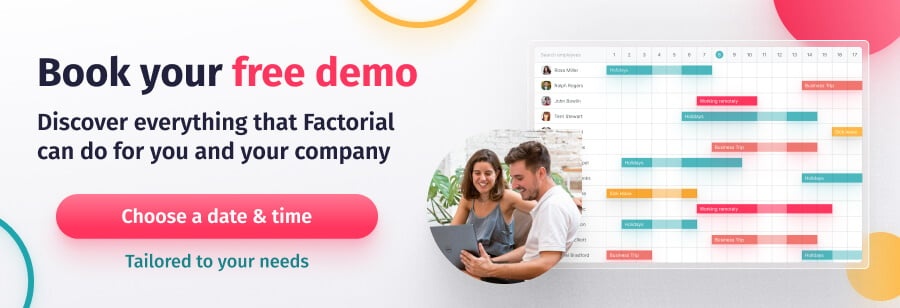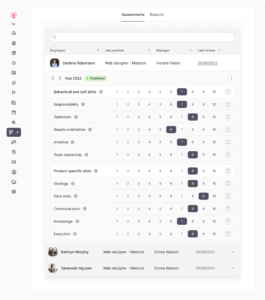Whatever your business’s size or industry, ’employee performance’ is essential for HR teams and managers. But what exactly does it mean, and why is it so crucial for companies?
At its core, employee performance is the dynamic between an individual’s efforts and their outcomes within an organisation. But it’s not a one-size-fits-all, and employee performance management goes far beyond encouraging teams to complete tasks on to-do lists.
It encompasses the quality, effectiveness, and efficiency of an employee’s contributions to the broader goals and objectives of the company, and its management is a careful balance of optimising individual and team performance to help achieve organisational goals.
So, how should you address the performance equation? It’s not solely about numbers and metrics; it’s also about how they reflect and contribute to individuals’ personal growth and development within the workplace. Performance has to be managed systematically by setting expectations, tracking progress, offering feedback, and recognising achievements – and also empathetically, understanding individual needs.
In this article, we’ll delve into the heart of employee performance, how to manage it, and how it plays a significant role in any organisation’s success.
Whether you’re an HR professional, line manager, or an employee seeking to excel in your role, this article will offer insights to help you understand and navigate the world of employee performance.
1. Why Employee Performance Matters?
2. How is Employee Performance Measured?
3. Who is Responsible for Employee Performance?
4. What are the Elements of a Successful Employee Performance Strategy?
5. 10 Tips to Help Improve Employee Performance
6. Employee Performance with Factorial

1. Why Employee Performance Matters?
Employee performance is like the engine that drives business success. Good performance means you’re getting things done efficiently and effectively, and when your team consistently brings their A-game, the gears in your well-oiled machine turn smoothly. And when everything runs like clockwork, goals are met, and objectives are completed effectively – and on time!
More importantly, when your employees feel valued and their work matters, they’re not just turning up for the nine-to-five every day – they’re engaged, and they care about their work. Engaged and committed employees are more likely to stick around, reducing the costs of hiring and training new starters. On top of this, this kind of environment helps to create a positive workplace culture that attracts even more talent.
In short, effectively managing performance at work can tip the balance between how well your business operates, how satisfied your customers are, and how happy and dedicated your employees feel. It’s a win-win for everyone.
2. How is Employee Performance Measured?
Employee performance isn’t measured by one thing; it generally takes a whole host of metrics to get a well-rounded and comparable interpretation of each employee’s success in their role. What you choose to measure will also likely differ between departments and functions. However, some key metrics usually make up the core of an employee performance arsenal.
Here are some key employee performance metrics:
- Key Performance Indicators (KPIs): These are essential for measuring your employee’s performance against your organisation’s goals. They’re quantitative, so easy to compare, and you should consider them as the benchmarks for success in different roles – like sales targets, customer satisfaction scores, or project completion rates.
- 360-Degree Feedback: Like it says on the tin, this is getting feedback from every angle. It involves peers, managers, direct reports, and the employees themselves. 360-degree feedback is increasingly popular in today’s working world because it gives a well-rounded, real time view of how someone is doing.
- Staff Appraisals: These are the more traditional employee and line manager check-ins, usually once or twice a year, where a manager sits down with an employee to discuss their achievements, strengths, and areas where they can improve.
- Goal Achievement: This one’s all about whether employees are hitting the specific objectives set for their role. This metric directly measures whether an individual is doing what’s expected of them.
- Customer Feedback: If your employees interact with customers, their performance can also be measured by looking at their customers’ feedback. Things like customer satisfaction scores and reviews can add clarity to how someone is performing their role.
Remember, the right mix of these measures will depend on your organisation’s goals and the specific roles you’re evaluating. The key to managing performance at work is to ensure each employee is clear on what success looks like for them and that the metrics are tailored to help them achieve their potential.
3. Who is Responsible for Employee Performance?

Like with metrics, no individual stakeholder is responsible for employee performance within a business. The responsibility lies across all levels of the company, these include:
Team Leaders and Managers
Your frontline leaders, such as managers and supervisors, play a pivotal role in employee performance. They set expectations, provide feedback, and coach employees. Think of them as the day-to-day drivers of performance.
Human Resources
HR teams significantly shape and implement performance management strategies. They design performance appraisal processes, provide training, and often act as mediators in any performance-related issues. They’re like the architects of the performance system.
Employees
Employees are not just passive participants; they have a crucial role in their own performance. They need to take responsibility for meeting performance goals, seeking feedback, actively engaging in their development, and driving their performance forward.
Senior Leaders
High-level leadership, including executives and top management, set the tone for the entire organisation. They establish the company’s culture, values, and long-term objectives, and their commitment to fostering a culture of performance excellence is essential.
4. What are the Elements of a Successful Employee Performance Strategy?
Successful employee performance strategies are built upon a foundation of tactics. These include:
- Clear and Specific Goals: Setting clear, measurable, and achievable performance goals that align with the company’s objectives.
- Regular Feedback and Communication: Maintaining open lines of communication and providing ongoing feedback and guidance to employees.
- Employee Development and Training: Investing in employee growth by providing opportunities for skill development.
- Recognition and Rewards: Acknowledging and rewarding employees for their efforts and achievements.
- Performance Measurement and Data Analysis: Using data and metrics to measure and evaluate employee performance, you can identify trends and areas for improvement.
While these can provide a solid framework, it’s crucial to tailor your approach to your organisation’s unique culture and needs and always remain open to enhancements in your performance strategy.
5. 10 Tips to Help Improve Employee Performance
- Set well-defined, measurable objectives aligned with company goals.
- Offer constructive, timely feedback to guide progress
- Support continuous learning and skill development
- Acknowledge and reward high performers to motivate
- Create a positive working culture and an environment that promotes collaboration, inclusivity, and well-being.
- Allow employees to make decisions and take ownership of their work.
- Make sure your teams have all the resources, tools and systems they need
- Encourage work-life balance
- Foster transparent, two-way communication
- Support and encourage career growth opportunities
6. Employee Performance with Factorial:

Factorial’s Employee Performance tool is designed to help small and medium-sized businesses effectively manage employee performance. We’ve crafted a powerful and user-friendly solution to help you drive employee growth and company success.
With Factorial you can:
- Set Objectives: Create diverse objectives and goals aligned to individual roles and development and your company’s broader vision.
- Personalise Goals: Manage your employees’ performance with OKR software you can tailor to your needs.
- Track your progress: Track milestones and progress for the business, teams and individuals with our employee goal-setting software.
- Help your busines grow: Establish measurable KPIs to enable your business’s growth.
- Customise the platform for you: Assign goals with specific timeframes, matching them to roles and seniority levels, and integrate seamlessly with our Performance Management tool for comprehensive 360 reviews.
- Make Data-Driven Decisions: Leverage data from our HR Reports & Analytics tool to respond to trends and inform your future goals and objectives.
Our Employee Performance tool is part of a complete HR software package. Manage time, holidays, payroll, performance, and more, all from one place, with Factorial.
Join the 8,000+ companies worldwide that trust us and discover why we’ve earned a spot in G2’s Top 50 HR Products 2023.


